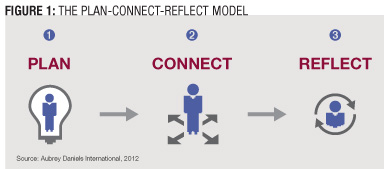“What are you assuming about me?” asked Jamie L. Scarano, the director of integrated inclusion and internal operations at the University of Pittsburgh Medical Center (UPMC), to a room of HR professionals at the Society for Human Resource Management (SHRM) conference in Atlanta last week.
It was 7 a.m. on the second day of the conference, an event that attracted thousands of professionals from around the globe, and Scarano was about to explain the regional hospital system’s inclusion strategy — the Dignity & Respect Campaign — which had grown from an internal effort to a national campaign in a matter of years.
Scarano asked the question to make a point: An effective inclusion strategy should not be based on playing to stereotypes — it should be about playing to individuals’ personal stories. “Really look at people and their journey and what they bring to the table,” she said.
The University of Pittsburgh Medical Center is a complex organization. It has 55,000 employees, many of whom are spread across multiple hospitals and facilities hours away from one another. The system also hires roughly 300 new employees per week, Scarano said, and many of those hires make up non-medical staff — administrative, marketing, finance and human resources.
In November 2008, UPMC’s Center for Inclusion introduced the campaign in an effort to promote a broader sense of accountability — to unify a shared belief that everyone deserves to be treated with dignity and respect. “Inclusion begins with a core believe that everyone deserves dignity and respect,” Scarano explained.
Prior to the campaign, the system’s inclusion efforts had largely revolved around simple diversity training, with one person responsible for the entire system. The training would mostly be concentrated on discussions around race. “He would train and talk mostly about race [and] we would receive one poster for Martin Luther King Jr. Day,” Scarano said. “It was about training, posters and you had a diversity recruiter.”
But that would change.
Through a series of focus groups and “road shows” with employees, UPMC’s Center for Inclusion — a unit created to promote the Dignity & Respect campaign — eventually created what Scarano called a dignity and respect toolkit, a series of competency values and grassroots guidance for employees to refer to day in and day out. The idea was to ask employees to become their own inclusion champions.
Part of the toolkit, for instance, included “30 Tips of Dignity & Respect,” a reference sheet featuring simple steps — smile, say “hello,” say “thank you” — that were distributed and pinned up throughout the system’s facilities. Some hospitals within the system implemented a “tip of the day” posted up on the wall near common areas.
The campaign also created an annual award, a “Dignity & Respect Champion Award,” which Scarano said was intended to promote a greater sense of integration and to encourage employees to become active in the campaign.
“Over time, [those] leaders tell their stories,” Scarano said. Sharing individual stories became the heart of the campaign. It acted as a grassroots method for employees to learn about each other’s individual journeys, thus promoting a greater sense of unity throughout the system’s culture.
The success of the campaign is measured through culture surveys. UPMC’s Center for Inclusion then meets with individual business leaders after survey results are evaluated to work on areas of improvement “The goal is for each business unit to focus on their results,” Scarano said. “[Then we] meet with the individual leader after survey results: ‘This is what your employee said about your culture. What are you going to do to impact that?’”
In October 2009, the campaign went external into the Pittsburg community. The mayor even declared October “Dignity & Respect Month.” More than 100 organizations, schools and communities across the U.S. have engaged in the initiative since, according to the campaign’s website.
While they are still working on putting together more advanced metrics to measure the reach of the campaign internally, much of the measurement has come empirically.
For instance, through the system’s heightened level of inclusion and awareness, one employee unit has started the tradition of bringing in foods from their individual ethnicities to share with one another — a simple act that builds a sense of community among workers.
Such simple gestures are representative of the campaign’s original goal of unifying the workforce around each employee’s unique perspective and promoting individualism, Scarano said.
“Simple things like luncheons, where everybody brings food from their ethnicity — that slowly became something that they do annually,” she said. “It gets people talking. It gets people engaged.”
Frank Kalman is an associate editor of Diversity Executive magazine. He can be reached at fkalman@diversity-executive.com.















